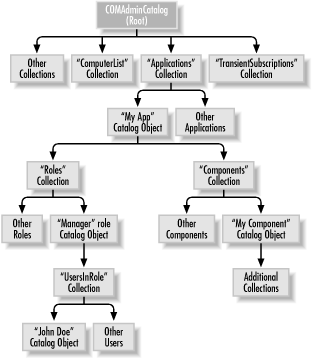Catalog Structure
This section discusses the Catalog structure and
the names of the items in it, not the semantics of these items. Some
of these items have already been covered in the previous chapters,
and some are covered in subsequent chapters. The COM+ Catalog’s
actual structure, from the root down to the component level, is
mapped out in Figure 6-2. Each collection has a
predefined identifying name, whereas catalog objects’ names are
defined by the user. The root of the Catalog gives you access to
top-level collections such as the Applications and
TransientSubscription
collections (see Chapter 9). You can also access less useful collections
such as the communication protocols used by DCOM or all of the
in-proc servers (COM objects in a DLL) installed on the machine.
Another top-level collection shown in Figure 6-2 is
the ComputerList collection—a list of all
the computers that the Component Services Explorer is configured to
manage.

Figure 6-2. The COM+ Catalog structure, from the root down to the component level
The Applications
collection, as the name implies,
contains all the COM+ applications installed on the machine. A
catalog object in the Applications collection
allows you to set the properties of a particular COM+ application. It
also gives you access to two other collections: the
Roles and the Components collections. As mentioned previously, every folder in the Component ...
Get COM & .NET Component Services now with the O’Reilly learning platform.
O’Reilly members experience books, live events, courses curated by job role, and more from O’Reilly and nearly 200 top publishers.

